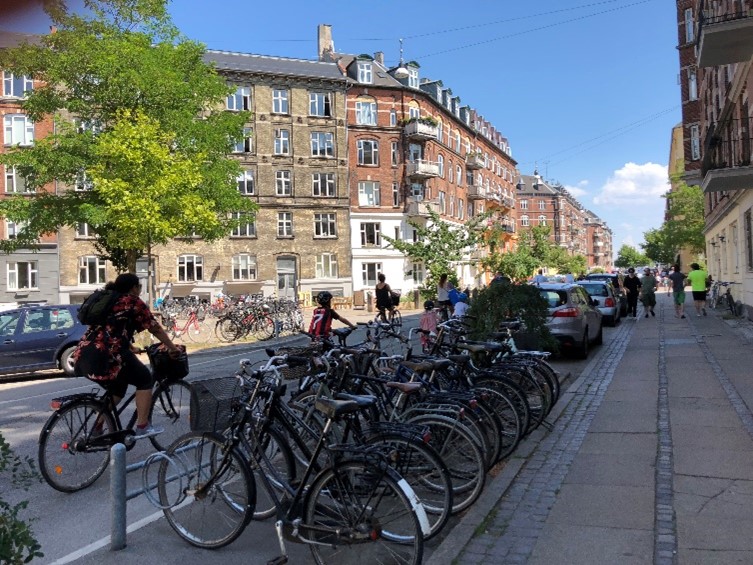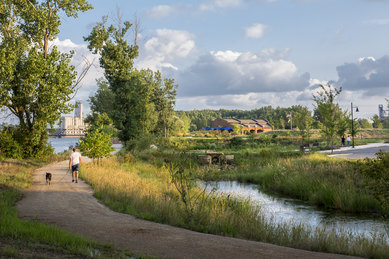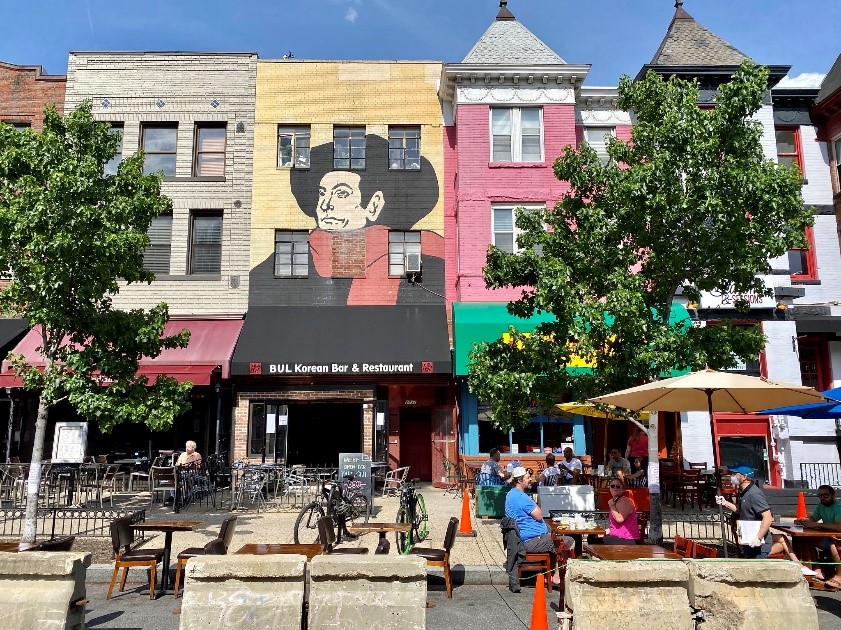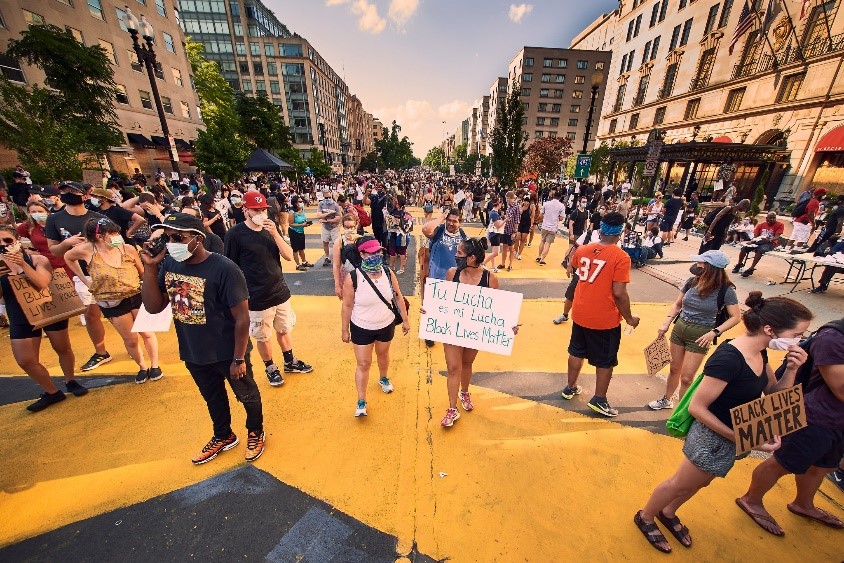Generosity of Space

Dequindre Cut Greenway, designed by SmithGroup
We needed better public spaces for all well before COVID-19. Now the need is even more urgent.
The COVID-19 crisis has brought into full focus the need for generously-sized, creatively designed public spaces that can be shared and used by everyone for many purposes -- such as walking, cycling, recreating and more. Whether people are still going to their workplaces, or spending more time indoors working or studying, they also want and need to spend more time outdoors to get around safely, to feel mentally and physically healthy, to connect with nature, and to participate in cultural and civic life.
However, the reality is that we have needed wider sidewalks and trails and more spacious parks and open spaces -- which would function very differently than they do today -- long before the onset of COVID-19. We also needed better spaces -- which are accessible to everyone and work for all of us. Our cities’ public spaces have many demands on them. In some cities, these spaces have been inadequate to meet demands and are compromised in their accessibility to many. Consider some of the many uses of public space, for better or for worse, and how they are now being reimagined to accommodate public life with COVID. Then consider how much better they might be in a post-COVID world.
Spaces for Transportation and Storage
So much of the space in our city streets and public rights-of-way is given over to motorized vehicles for driving, parking, construction staging and as delivery/pick-up/drop-off zones. According to the National Association of City Transportation Officials, or NACTO, “Streets are the lifeblood of our communities and the foundation of our urban economies. They make up more than 80% of all public space in cities and have the potential to foster business activity, serve as a front yard for residents, and provide a safe place for people to get around, whether on foot, bicycle, car, or transit. The vitality of urban life demands a design approach sensitive to the multifaceted role streets play in our cities.”
Many argue that far too much roadway space has been traditionally allocated to vehicular uses. Meanwhile, with the growing focus on multimodal transport and the desire to be healthy and drive less, people are walking and cycling more. This has led to more bicycle and pedestrian conflicts with vehicles, resulting in many injuries and deaths. Some cities are trying to address these problems by implementing Vision Zero principles -- strategies and design elements to eliminate pedestrian and cyclist injuries and fatalities. As proven in countries like the Netherlands and Denmark, the most successful strategies involve converting some vehicular roadway and parking spaces to separated pedestrian sidewalks and protected bikeways.
The skewed allocation of so much space for motorized vehicles became more visually evident as automotive commuting plummeted in March of 2020. Many people were working from home or not able to work at all due to the COVID-19 pandemic, leaving streets much emptier. Simultaneously, there arose the need for more outdoor space for walking and cycling during stay-at-home orders, resulting in many cities reconsidering this allocation. Some cities, like Seattle, are making plans to close some streets permanently to cars making them cycling-and-walking-only streets and creating more space for physical distancing. Other cities are extending sidewalks and public spaces in order to provide room for restaurant “streateries,” allowing people to dine together outdoors while physically distancing from one another. Maintaining these changes post-COVID could also mean fewer bicycle/pedestrian/vehicle conflicts in the future, a win for all modes of transportation.
Spaces for Recreation and Health
Access to parks and green spaces is known to improve peoples’ physical and mental health. COVID-19 brought renewed attention to this need for physical and mental wellbeing, as more people sought the outdoors for recreation and healthy activity. The large numbers of people out on afternoons and weekends are resulting in crowding in parks and on trails.
However, as described in a recent study of 10 urbanized areas in the U.S., communities with less overall education and income, as well as communities of color, are associated with less access to urban parks and green space. Meanwhile, these communities are experiencing higher incidences of Coronavirus infections, a situation that could potentially be improved by expanding access to parks and green spaces.
While more numerous, better located, and generously-sized parks are needed in many neighborhoods, communities can also rethink their existing parks to help alleviate crowding and make more efficient use of the space; approaches include creating recreational spaces with multiple purposes and trails with parallel paths. The Fields at RFK in Washington, DC has playing fields that can be used for multiple sports. In British Columbia, Vancouver’s Stanley Park is ringed with a trail along its seawall with side-by-side but separate paths for cycling and walking.
SmithGroup, together with Nsipregreen, recently assisted the DC Office of Planning in conducting a Public Life Study for the intersection of Florida and New York Avenues NE -- an area notorious for its high number of accidents and an environment that is considered hostile to pedestrians and cyclists. Among many recommendations for the design of future public space in that study area, we suggested 1) increasing sidewalk widths and 2) making large public spaces flexible and adaptable to changing needs. These recommendations also address the need to integrate deaf space design principles such as providing spaces wide enough for deaf and hard-of-hearing community members to be able to sign while walking together, and creating spaces that can be used by individuals of all abilities by making them adaptable to peoples’ changing needs. We learned that by designing for the most vulnerable members of society, we can make better public spaces for all.
Spaces for Entertainment and Consumption
Loneliness was a huge problem in America long before the pandemic. According to a study by the Kaiser Family Foundation, about 22% of Americans say they “often or always feel lonely, feel that they lack companionship, feel left out, or feel isolated from others, and many of them say their loneliness has had a negative impact on various aspects of their life.” COVID-19 has exacerbated this situation, as stay-at-home orders magnify isolation, especially among the 35 million Americans who live alone.
For those at home, on-screen entertainment after spending time on screen during working hours can only go so far. We are social creatures and need to be together to maintain our wellbeing. People are now looking to outdoor spaces in which they can spend time together while physically distancing. On Capitol Hill in Washington, DC on Sunday afternoons, people gather around a local intersection to hear renowned urban jazz harmonica musician Frédéric Yonnet and his Band with No Name perform from the upper level of his home, windows wide open. Meanwhile, on nearby Barracks Row, people have begun patronizing restaurants that are serving customers outdoors so as to accommodate physical distancing requirements.
These types of social gatherings had limited public space to begin with, and the pandemic has created an increased need for large public spaces that can host outdoor events while accommodating physical distancing. Not every event needs its own space. Integrating flexibility into public spaces so they can be repurposed to accommodate multiple uses is an important strategy now and will continue to be post-COVID.
Spaces for Civic and Political Activism
Public space is also where democratic discourse takes place. Events such as rallies, protests, speeches, and parades require public spaces that can accommodate large groups of people. These events help bring issues to light and counter political apathy which can lead to low voter turnout. A 2018 CityLab article featured a map by Philip Kearny with data gathered from the U.S. Census Bureau and TownHall.com which showed that, "If no-show voters could choose a candidate, 'Nobody' would have won the 2016 presidential election.” The map summed up the astounding effect of low voter turnout, a condition which is often compounded during mid-term elections.
While it may be assumed that outdoor civic activism would be reduced during the COVID-19 crisis, the recent protests taking place following the deaths of George Floyd, Breonna Taylor, Ahmaud Arbery, and others demonstrate that this will not be the case. Meeting the need for public space for civic action while ensuring safety from the Coronavirus highlights the need for large, flexible public spaces in the service of a democratic society.
Conclusion
Today more than ever, we need generous, connective, and adaptable public spaces and rights-of-way to carry out our daily lives, to be healthy, and to participate in civil society. As designers and planners, we should consider the following practices in order to move toward creating more such spaces and ensuring that they serve all members our communities:
Design for Inclusion - Plan and design collaboratively with existing and future users before, during, and after the process (and not just with them in mind). Begin the approach with questions and without preconceptions. Make part of the process methodologies such as Public Life Studies, which use observations, fieldwork, interviews and data to uncover how public spaces really work today, and how community members wish them to work in the future. Traditional community engagement is often inhibiting for many because it requires people to come to the process. Make the process with them.
Design for Connection - Plan and design generous and barrier-free spaces that do not create physical or social obstacles but that promote and enable physical and social connectivity. Treat minimum requirements as just that, and go generously beyond them to provide solutions that work for more variety in conditions and in use. Whenever possible, test ideas with pop-ups and pilots before making changes permanent. When a place is designed to be accessible to and used freely by the most vulnerable, it will better work for everyone because no one is left out.
Design for Adaptation - Plan and design at every scale for the maximum level of adaptability and reuse possible. Whether a building or a park, structures and spaces should be flexible, movable, reusable, and reprogrammable; they must be adaptable to peoples’ needs, which can change over the course of a day, week, year, or generation. Adaptively designed places are inherently more sustainable and resilient because they can change more readily when necessary, while minimizing the need for demolition and the use of new resources.



